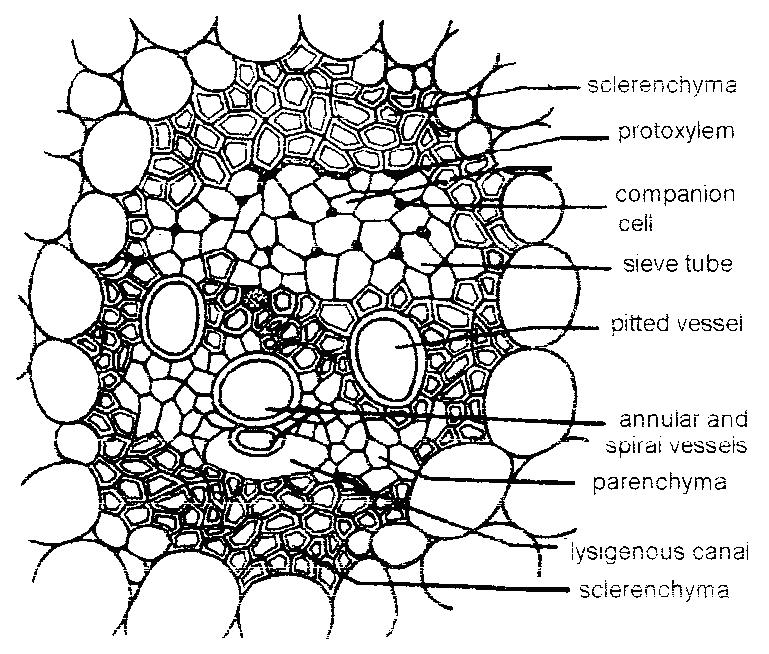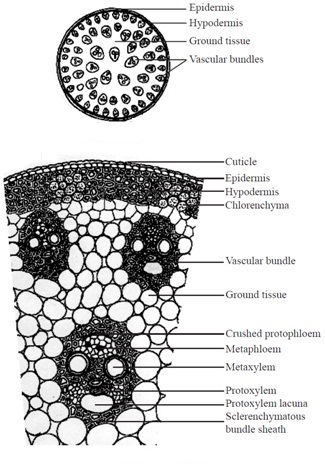Those plants whose seed contains only one cotyledon or embryonic leaf is known as monocotyledon or simply monocot. In this section, you will learn about characteristics and anatomy of monocot stem.
Visit this page to learn about dicot stem.
Characteristics of Monocot Stem
Typical monocotyledonous stems shows following characteristics:
- Circular stem, may have depressed structures due to the presence of lateral branches
- Have thick cuticle, single layered epidermis and epidermal hairs are absent
- Single layered cuticularised epidermis may contain multicellular trichomes
- Ground tissues are not differentiated into cortex and pith
- Hypodermis is generally sclerenchymatous
- It has no distinct endodermis and pericycle
- Epidermis contains stomata with guard cells.
- Scattered vascular bundles are surrounded by sclerenchymatous bundle sheath cells and called atactostele
- Each vascular bundle is oval, conjoint, collateral and closed
- There is no distinction between pith and pith rays
- Xylem is endarch, phloem is represented only by companion cells, seive tubes and little phloem fibers
Vascular Bundle of Maize Stem

Anatomy of Monocot stem
The transverse section of stem of maize(which is a monocot plant) contains following regions:
- Epidermis
- Hypodermis
- Ground tissues
- Vascular bundles
Transverse Section of Internal tissues organization of Monocot Stem (Maize)

- Epidermis is the outermost uniseriate cuticularised layer of parenchyma with stomata. It is made from arranged barrel shaped cells usually without epidermal stem hairs.
- Hypodermis is just internal to epidermis, made from compactly arranged sclerenchyma without intercellular spaces. It provides mechanical strength to the plant.
- Ground tissue is parenchymatous and not differentiated into cortex, endodermis, pericycle and pith as in dicot. These cells are smaller, polygonal, compactly arranged (toward center) or loosely arranged (toward peripheral). The scatter vascular bundles are imbedded in these tissues. These cells contain reserve materials.
- Vascular bundles are conjoint, collateral and closed. It has two types: larger and smaller and scattered in ground tissue without any order (atactostele). The large vascular bundles lie towards the center (less in number) and smaller towards and periphery (more in number). Each vascular bundles has oval outline and surrounded by a sclerenchymatous bundle sheath which encloses Xylem and Phloem.
- Xylem consists of vessels, tracheids, xylem parenchyma and limited xylem fibres. Vessel is Y-shaped with larger two round pitted metaxylem vessels forming the arms and smaller annual or spiral protoxylem vessels, forming the base. A large water cavity (schizolysigenous cavity, i.e. formed from disintegration of some protoxylem) is present in the inner side of the protoxylem. It stores water and also called lacuna or water cavity. The xylems are endarch with outer metaxylem and inner protoxylem.
- Phloem lies outside the xylem in the vascular bundle. It consists of sieve tubes, companion cells and phloem fibers, but lacks phloem parenchyma. The outer phloem is protophloem and functional metaphloem lie inner portion.